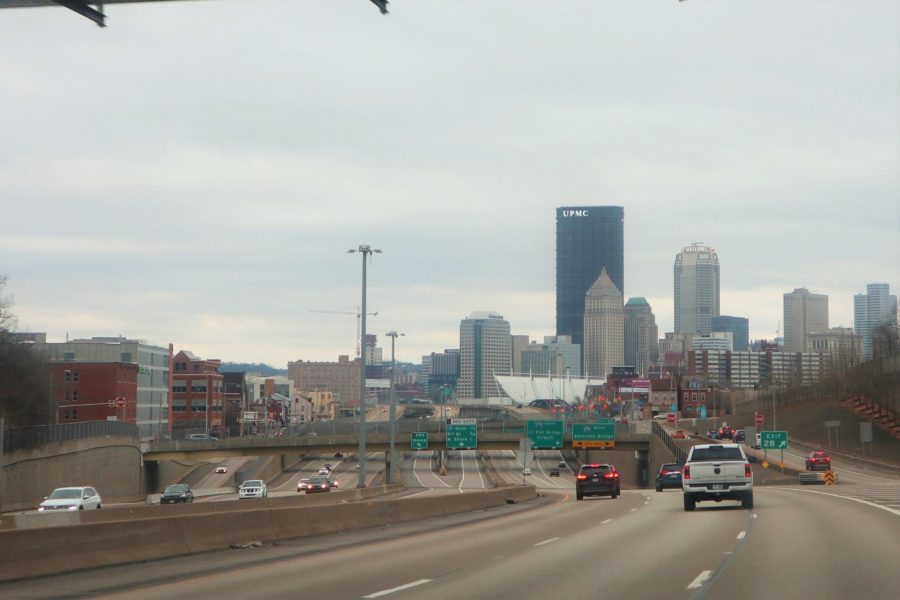Opinion: Shielded by Suburbia
Suburban residents need to voice more concern about violence in urban neighborhoods.
Driving into Pittsburgh on I-279, it is clear how the highway divided the North Side into two halves.
January 5, 2023
On September 24th, I was at Kennywood Park during the non-fatal shooting that left three injured. Though I was not near the shooter, I will always remember the frightened family who joined us in hiding under the Jack Rabbit roller coaster, making a tearful phone call.
While we were crouched and hiding in fear, it struck me that many of my suburban neighbors would likely awake the next day and consider the Kennywood shooting as nothing more than a notable news event. Witnessing at least one instance of urban violence myself, I realized that even though it is impossible to understand the difficulties of city life without firsthand experience, even people who live in distant suburbs can work for greater public awareness of the plight of urban violence.
It is too easy to turn a blind eye to the distressingly innumerable number of shootings and attacks we hear in the news, but it is our responsibility to never overlook the issues of urban violence, even when it can be tempting to ignore them. We must realize that those affected by violence are not wholly responsible for their situation; rather, they are victims of how cities have changed with the passing of time.
Urban violence is often a result of decades of decline due to a changing economy and unfortunate urban planning–both of which occur at no fault of an area’s residents–yet many people are unconcerned with the struggles of city dwellers. As Pittsburgh’s suburbanites speed north after working their 9-5 job downtown, I-279 slices through the city’s North Side. More than 1,800 families were forced out when this interstate was constructed in the 1980s, but most are likely unaware of its detrimental effect on the North Side. The schism created by I-279 added to the North Side’s woes in the wake of Pittsburgh’s decline in heavy industry, unintentionally fracturing the community and leaving it prone to violence, such as the shooting in October on Cedar Avenue that left three people, including two bystanders, dead.
Other stories of failed urban renewal play out elsewhere in the city: 80 blocks of the African-American-dominated Lower Hill District were flattened for the construction of the new Civic Arena in the early 1960s, and the commercial hearts of the old North Side and East Liberty were demolished for concrete shopping malls.

When communities are ruthlessly divided by violence, it should be everyone’s responsibility to ensure that their residents have an opportunity to thrive, yet poor neighborhoods are often ignored by those families who fled to the suburbs decades ago.
By understanding the origin of urban violence, even those who live far away can help to improve the standard of living in urban communities. Rather than continue to distance ourselves from cities, we should return to them. Patronizing the small businesses of underprivileged neighborhoods can help to improve a community’s economy, in turn leading to a decrease in violence throughout the community. Small businesses are an important part of creating a tight-knit sense of community, which is a valuable asset to any neighborhood.
Despite a 21% drop in unemployment from 2008 to 2018, wealth in Pittsburgh is unevenly concentrated in affluent neighborhoods. The Gini index measures income inequality, or how evenly income is distributed across a population, on a scale of 0 (completely equal) to 1 (completely unequal). In Pittsburgh, the index was 0.5282 in 2021, or about 8% above the national average.
Before the quality of life in urban neighborhoods can be improved, one must understand the context of why these communities began to struggle. When people are abandoned in a changing urban landscape, it is our responsibility to never overlook the problem of violence, as giving in to ignorance is simply too tempting.
Still, the first step to abating this issue is simply raising awareness. By ensuring the public is aware of why some urban neighborhoods were left behind in the first place, we can invest back into these communities to fix the long-standing issue of economic neglect, aiding in the neighborhood’s recovery.
Much has been said of Pittsburgh’s rapid growth in the fields of technology and medicine, but the benefits of this change have not been universal. Some neighborhoods are still waiting to be revitalized years after the region’s loss of industrial jobs. While Highland Park enjoys an average median income of $60,892, neighboring Larimer sees an average income of $20,358. Additionally, one in five Pittsburgh residents lived in poverty according to data released by the US Census Bureau in September, almost eight percentage points higher than the national average.
I have used Pittsburgh as a case study, but a similar pattern is true for struggling communities across America’s Rust Belt; once people begin to leave, the cycle of decline becomes hard to stop. For those who may be shielded by suburbia from urban neighborhoods, conversations on how to approach the issue of violence in our own cities should never be avoided–instead, they should be welcomed.
_________________________________________________________
Editors’ note: All opinions expressed on The Uproar are a reflection solely of the beliefs of the bylined author and not the journalism program at NASH. We continue to welcome school-appropriate comments and guest articles.














